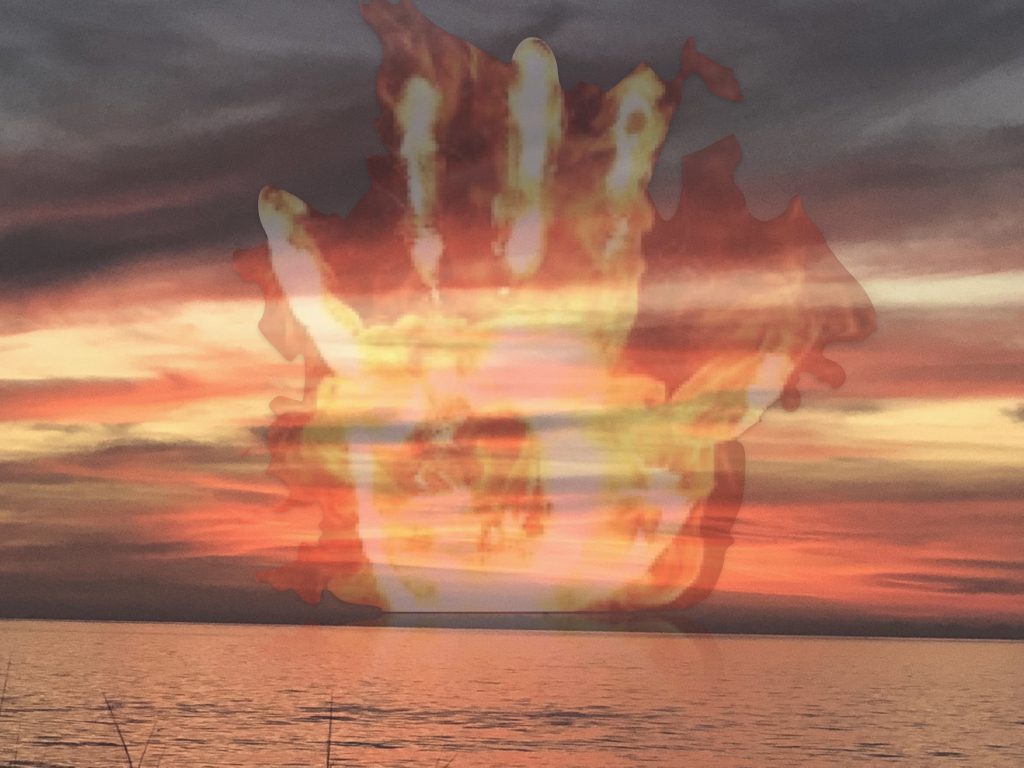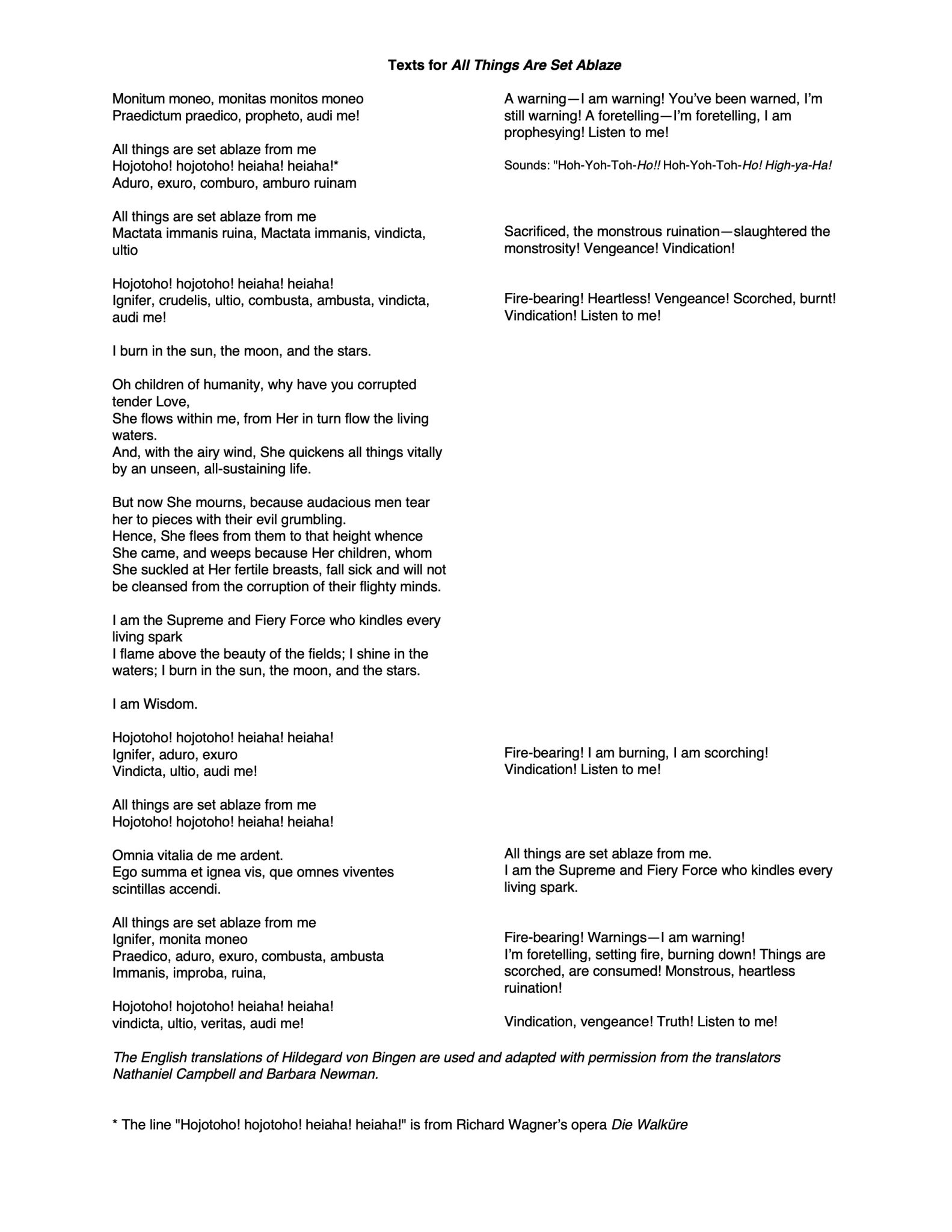From: All Things Are Set Ablaze
Instrumentation
for 2 sopranos, & mezzo-soprano, each playing hand percussion
From: All Things Are Set Ablaze is an excerpt of a more extended work. The text is by Hildegard von Bingen, compiled and annotated by Joel Phillip Friedman, and based upon translations by Nathaniel Campbell and Barbara Newman. Contact the composer about the extended version.
Program Note
We pick up the piece at its mid-point:
I imagine a modern Hildegard von Bingen, rising up and returning to tell us “you have lost your way and face destruction, listen to me now… or face the consequences.” She warns, in her own words: “All Things Are Set Ablaze… From Me!” My invented Hildegard is a mixture of the real and prescient woman of many enormous talents and startling visions, Wagner’s Valkyrie warrior Brünnhilde, the future prophesying Oracle of Delphi, and perhaps even a badass Wonder Woman. Most of the words I set are Hildegard’s own, in English translations by Medieval Latin scholars Nathaniel Campbell and Barbara Newman. If Hildegard’s writings initially had…a slightly different context… they do speak with potent currency today. I have added some non-Hildegard text: short cautionary Latin fragments (e.g. “Monitum… Praedictum… Ignifer… Audi me” – “A warning… Foretelling…Fire-bearing… Listen to me!), as well as, fittingly, a single line from Wagner’s opera Die Walküre – the famous Valkyrie war cry (“Hojotoho! hojotoho! heiaha! Heiaha!”). If Hildegard were to return today I imagine she would identify with Brünnhilde and join her singing those spirited words! You will hear All Things Are Set Ablaze starting at its middle, slower section. As the piece’s opening music returns at the end, you will hear a portion of it. The work has been trimmed to be proportional with the rest of the program.
I’d like to thank Nathaniel Campbell and Barbara Newman for allowing me to use and adapt their Hildegard translations, and for Nathaniel’s invaluable help wordsmithing the additional Latin portions. The work is dedicated to Jacqueline Horner-Kwiatek and her ensemble ModernMedieval Trio of Voices, who have commissioned it.
World Premiere: ModernMedieval Trio of Voices on the Shenson Chamber Music Series, Gilan Tocco Corn, Artistic Director, National Museum of Women in the Arts, Washington D.C. on May 9, 2018.
This work was developed while in residence at the Lucas Arts Residency Program, Montalvo Arts Center, and the Hermitage Artist Retreat. With thanks!
Listen
Excerpt
Watch
Listen
Performing Notes
Hand percussion instruments:
- Soprano I
- Tambourine
- Soprano 2
- “Frame drum” – a tambourine without the jingles will do, ideally mounted on a stand to allow playing with sticks. Although hand-held will do. A small drum – low bongo, djembe, or dumbek – would be even better for more variation and a deeper sound.
- Mezzo-soprano
- Triangle (hanging from the music stand or mounted on a stand)
- Crotale, on C (hanging from the music stand or mounted on a stand)
- Both are played with a metal beater (or stick) heavier than the usual triangle beater.
- Music Stand Shaft played with the aforementioned heavier metal beater/stick. Alternatively, any of the following could work: a length of metal pipe played with a metal “beater” (or wrench), a bicycle lock hit with a wrench, or a low brake drum or an anvil. The desired sound is metallic and dramatic, with presence, and far deeper than a triangle!
- NB: Please do NOT use collapsible music stands unless a suitable alternative replacement instrument is available (e.g. a pipe)!!
Mm. 46-54 would be greatly enhanced by these same additional instruments creating a luminous, sparkling effect behind the vocals. I would happily supply additional rhythm parts.
It is possible to set up the triangles and tambourines/frame drum on stands for maximum flexibility and comfort in performance (not to mention freeing the hands).
Ad lib. Is written in the percussion parts as embellishing in the correct performing style (a cross between Medieval and 21st Century) is encouraged as the performers get to know the piece and feel more comfortable with the groove.
It would be very ideal for pairs of finger cymbals, or additional triangles or crotales, to be added to the mix so all three singers could perform on these instruments to create a more magical, shimmering sound.
- For example, mm. 1, 63, 165, and 270 would benefit from all three singers playing bell-like instruments and creating a unified theatrical gesture – “we are as one.”
Text

Score Preview
Review
“The largest, most ambitious work was Joel Phillip Friedman’s “All Things Are Set Ablaze,” during which the singers accompanied themselves on triangle, drum and tambourine, providing an earthy undergirding for more abstract elements in a diverse yet cohesive work of considerable power.” Patrick Rucker, Washington Post
